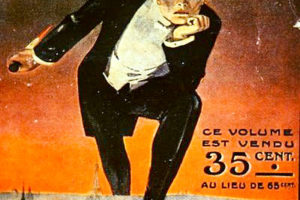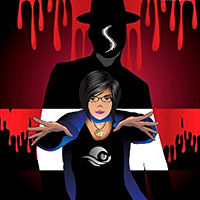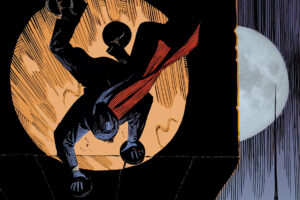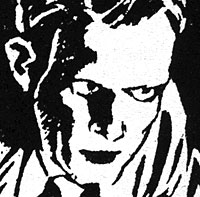
Street & Smith’s The Avenger, while not as popular as their successful characters The Shadow and Doc Savage, is one that remains popular to this day.
Street & Smith, like many other pulp publishers, tried to repeat the success of their two main characters, with only small success. They followed up The Shadow and Doc with Bill Barnes, Nick Carter and Pete Rice. These lasted for few years, to be replaced by The Whisperer and The Skipper. In an attempt to repeat the success of their main two, The Whisperer was created in the spirit of The Shadow, and The Skipper in the spirit of Doc. But they lasted only 12 issues, moving on to backup stories in their inspiration’s magazines, shorter lived than the heroes that inspired them.
With The Avenger, Street & Smith tried to combine elements of both The Shadow and Doc Savage. They brought together Walter Gibson and Lester Dent with pulp author Paul Ernst to pitch ideas to help him create The Avenger and to suggest elements of those other two characters to combine into this new one. At least The Avenger outlasted The Whisperer and The Skipper.
And that’s the story that most fans known and accept. Heck, one person thought that Gibson may have written some of the early Avenger stories!
What is forgotten is that Paul Ernst was writing pulp stories before The Avenger, which started in September 1939. Before this, he had created the Doctor Satan series for Weird Tales in 1935-36. And he was creating other characters, both one-off and series, many of whom had elements of The Avenger.
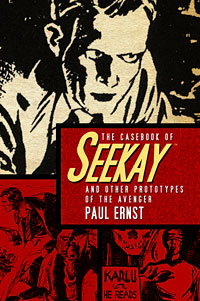 It’s thanks to a great Ernst collection from Altus Press, titled “The Casebook of Seekay and Other Prototypes of The Avenger,” that sets things straight by showcasing the characters that Paul Ernst created before The Avenger but have characteristics of The Avenger, and showing us that he probably came up with many of the ideas of the character.
It’s thanks to a great Ernst collection from Altus Press, titled “The Casebook of Seekay and Other Prototypes of The Avenger,” that sets things straight by showcasing the characters that Paul Ernst created before The Avenger but have characteristics of The Avenger, and showing us that he probably came up with many of the ideas of the character.
First off, we have Seekay. A private detective with a disfigured face hidden behind a plastic mask. He ran for five stories, first two in Popular Publications Strange Detective Stories, then in Detective Tales in 1937 and ’38. We never know what happened to him.
Seekay appears to be independently wealthy, as he takes cases only if he’s interested in them (like The Avenger). In the first story, he helps a girl who becomes his assistant (and who helps the reader in finding out what Seekay is doing). In a couple of stories he allows the traps of the bad guys to kill them (again, like The Avenger). I certainly think this character could have continued past those five stories, he was that interesting.
The rest of the stories in Altus Press’ collection feature one-off characters (but again, some could have been turned into serial characters).
There is The Wraith, a triple-identity crimefighter who utilizes a knife and a gun very much like The Avenger’s Mike and Ike, and has a partially paralyzed face. The Wraith is able to alter his appearance. This story seems to show the end of The Wraith’s career, as he was going after certain criminals for a certain crime, but the setup of the character seems wasted on this. With some tweaks he could have gone after more criminals, and been a long-running serial character. He appeared in Popular’s Detective Tales in 1936.
There is Dick Bullitt and his gray features. He is really more an attorney than a detective, but he is able to solve a serious crime. Other than his personality, he has little in common with The Avenger. Of all the stories, why this one was included puzzled me. He also appeared in Detective Tales in 1936.
There is Old Stone Face, the G-man with the emotionless visage, whose personality is very similar to The Avenger. He is after a racket which murdered his wife, and is described in the story as an emotionless machine, almost on a suicide mission to get the killers. He appeared in Ace G-Man Stories in 1937.
There is The Gray Marauder, who uses a dual identity to fight crime. What is interesting is he’s never called “The Gray Marauder” That’s only in the title. Here, an attorney uses a second identity to find evidence and help the innocent. In that second identity, he dresses all in gray, hence the name used in the title. Again, this character could have been an ongoing serial character easily. He appeared in Detective Tales in 1937.
And finally, Karlu, the mystic. He appeared in Detective Tales in 1938. He’s a mentalist who is also a criminologist (a strange combination). In this story he goes up against a group of side-show freaks who are blackmailing a town (a common theme among many of these stories). Again, he could have been a serial character, but another one I puzzled about his connection to The Avenger.
This is a great collection of early pulp heroes, and a great addition to anyone’s library of pulp fiction, especially those who are fans of The Avenger.

